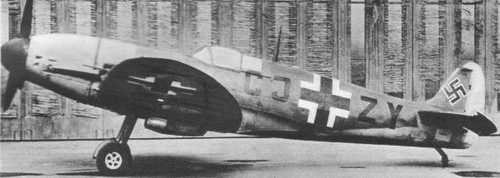
German Air Force
The German Spitfire
Aggelos Photo Collection
Now this is an interesting photo. A Spitfire tested with a Daimler-Benz 601 engine. Here is what I found: Spitfire Vb serial EN830 / NX-X fell into German hands late in 1942. It crash landed on November 18th 1942 while being flown by P/O (Sous Lt.) Bernard Scheidhauer of the Free French Air Force, attached to 131 "County of Kent" Sqn. RAF. He and his No.1, P/O Henri de Bordas, had been on a "rhubarb" to Normandy during the afternoon. EN830 was hit by light flak and made a forced landing in a turnip field at Dielament Manor, Trinity, Jersey. Sous Lt Scheidhauer was taken prisoner by the Germans and, like his aircraft, was transported to Germany. On March 24th, 1944 he and 80 other RAF officers escaped from Stalag Luft 3. He was captured along with his escape partner Sq. Ldr. Roger Bushell in Saarbrucken. The were both shot for their part in the "Great Escape" on 28th March 1944. His aircraft was captured virtually intact, and in good enough condition to be flown in November 1943, with black crosses in place of RAF roundels, to Rechlin for testing. Enlarge image (will open in a new window)In early spring of 1941, another Spitfire had been tested here. A suggestion that it be tested with a Daimler-Benz engine to enable a more direct comparison with the Luftwaffes' Messerschmitt Bf.109 led to it being flown to the Daimler-Benz facility at Backnang, near Stuttgart, on April 24, 1941. There it was to receive a DB 601 engine. This work proved to difficult and the project was abandoned. That aircraft returned to Rechlin on September 9, 1942. Enlarge image (will open in a new window)The acquisition of the second Spitfire, EN830, revived the idea. The Spitfire was sent to Echterdingen, south of Stuttgart, where Daimler-Benz operated a flight testing division. Flugkapitän Willy Ellenreider and his staff were responsible for testing to improve performance of other current aircraft, and a number of types served as flying test-beds. Among them were Ju.52s with a DB 605 engine in the centre position; He.111s, Hs.130s, Bf.109s and 110s, a Ju.87 and an Fi.167. Spitfire EN830 was repainted to German standards, dark green above and pale blue below, with bright yellow tail control surfaces and large, black crosses. Radio code letters CJ+ZY were painted on each side, below and, unusually, above the wings; and the British serial transferred to the fin above the swastika. The Spitfire reached Echterdingen minus guns and ammunition, with the gun ports closed. The radio had been replaced with ballast, but it still had its original Merlin 45 engine. Several flights were made by Daimler-Benz pilots before conversion was attempted. A decision was made to replace the intruments and the entire electrical system with standard German equipment, because the Luftwaffe used a 24 volt system, whilst the RAF used a 12 volt standard. After the Merlin engine was removed, it was discovered that the Spitfire's front fuselage cross-section was very close to that of the standard Bf.110G's engine cowling. A new engine support was designed, and a standard DB 605A-1 engine (Wk-Nr 00701990) was mounted to the fire wall. The work was completed at the Sindelfingen Daimler-Benz factory, near Echterdingen. A 3.0 m. diameter Bf.109G propellor was added, together with the carburettor scoop from a Bf.109G. This made the modified Spitfire's all-up weight, without armament, 6,020 lb. (2730 kg). The armament weight was an estimated additional 661 lb. (300 kg.). Its weight with armament, before the engine modification, had been 6,680 lb. (3030 kg.). After a couple of weeks, and with a new yellow-painted nose, the Spitfire returne to Echterdingen. Ellenreider was the first to try the aircraft. He was stunned that the aircraft had much better visibility and handling on the ground than the Bf.109. It took off before he realised it and had an impressive climb rate, around 70 ft. (21 m.) per second. Much of the Spitfire's better handling could be attributed to its lower wing loading. The Spitfire's wing area was about 54 sq. ft. (5m²) greater than that of the Bf.109. The Messerschmitt was faster at low altitude, but at 11,000 ft. (3350 m) the speeds evened out. The DB 605A engine gave better performance, according to the test group, than the Merlin, which was rated 150 hp below the German engine. It gave the Spitfire a ceiling of 41,666 ft. (12700 m.), about 3,280 ft. (1000 m.) more than a Bf.109G with the same engine and 5,166 ft. (1475 m.) more than that of a Spitfire Mk.V. After a brief period at Rechlin confirming the performance data, the modified Spitfire returned to Echterdingen to serve officially as a test bed. It was popular with the pilots in and out of working hours. Its career ended on 14th August, 1944, when a formation of US bombers attacked Echterdingen, wrecking two Ju.52s, three Bf.109Gs, a Bf.109H V1, an FW.190 V16, an Me.410 and the Spitfire. The remains of the hybrid Spitfire were scrapped at the Klemm factory at Böblingen.
8775 Views
9/11/2013
